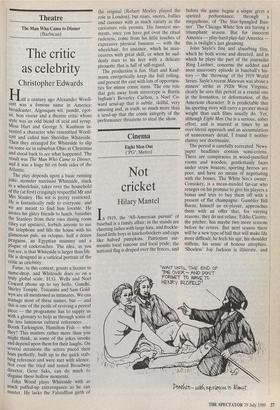Theatre
The critic as celebrity
Christopher Edwards
Half a century ago Alexander Woo11- cott was a famous name in America: broadcaster, Algonquin wit, pundit, egot- ist, bon viveur and a theatre critic whose Style was an odd blend of acid and syrup. Moss Hart and George S. Kaufman in- vented a character who resembled Wooll- cott and called him Sheridan Whiteside. Then they arranged for Whiteside to slip on some ice in suburban Ohio at Christmas and stood back to see what happened. The result was The Man Who Came to Dinner, and it was a huge hit on both sides of the Atlantic.
The play depends upon a basic running joke:, monster narcissist Whiteside, stuck in a wheelchair, takes over the household of the (at first) cringingly respectful Mr and Mrs Stanley. His wit is pretty restricted. He is fantastically rude to everyone, and We are meant to find him lovable. He invites his glitzy friends to lunch, banishes the Stanleys from their own dining room (they eat upstairs), forbids anyone to use the telephone and fills the house with his glamorous pals, an octopus, half a dozen Penguins, an Egyptian mummy and a Plague of cockroaches. The idea, as you can see, is that Whiteside is larger than life. He is designed as a satirical portrait of the critic as celebrity.
Fame, in this context, grants a licence to ' name-drop, and Whiteside does so on a truly global scale. H.G. Wells and Noel Coward phone up to say hello, Gandhi, Shirley Temple, Toscanini and Sam Gold- wyn are all mentioned as intimates. We can manage most of these names, but — and this is one of the perils of reviving a period Piece — the programme has to supply us With a glossary to help us through some of the less luminous cultural references . . . Booth Tarkington, Hamilton Fish — who they? This matters rather more than you might think, as some of the jokes invoke and depend upon them for their laughs. On several occasions the actors paced their lines perfectly, built up to the quick stab- bing reference and were met with silence. Not even the tried and tested Broadway director, Gene Saks, can do much to disguise these hollow moments.
John Wood plays Whiteside with as much puffed-up extravagance as he can muster. He lacks the Falstaffian girth of the original (Robert Morley played the role in London), but roars, snores, bullies and caresses with as much variety as the caricature role permits. His funniest mo- ments, once you have got over the ritual rudeness, come from his little touches of expressive physical business — with the wheelchair, for instance, which he man- oeuvres with great skill, or when he sud- denly rises to his feet with a delicate pirouette that is full of self-regard. The production is fun. Hart and Kauf- mann energetically keep the ball rolling, and present the cast with lots of opportuni- ties for minor comic turns. The one role that gets away from stereotype is Barrie Ingham's Beverley Carlton, a Noel Co- ward send-up that is subtle, skilful, very amusing and, in truth, so much more than a send-up that the comic integrity of the performance threatens to steal the show.


















































 Previous page
Previous page